By: Julio Poletti/ @JulioPoletti
[Note: Before you jump into the reading, get into the Wednesday soul-less spirit by jamming to the playlist below.]
Wake up! You've been binge-watching Wednesday, the latest spinoff of Addams Family on Netflix. It's okay. We're hooked on it too. Want to know what makes Wednesday feel all warm and fussy inside? Spooky animals! Visit the Denver Museum of Nature & Science and find these 7 famous Halloween protagonists around our exhibitions and dioramas. Make Wednesday proud!
View this post on Instagram
Social media challenge: See if you can find all 7 spooky animals at the Museum and post a reel, story or carousel on your social media and tag us at @Denvermuseumns and use the hashtag #WednesdayDMNS or #HalloweenDMNS. We will repost your post, reel or picture on our story!
Mexican Free-tailed Bat
Scientific name: Tadarida brasiliensis
Diet: Insectivores. These bats eat small flying insects that are out at night. They can eat and fly at the same time!
Sleeping pattern: This species of bat is nocturnal. During the day, they roost together with other bats until the sun goes down. Then, they emerge from caves, old mines, or under bridges and fly around at night.
Normal behavior: Echolocation is when an animal can identify the location of objects by reflected sound. Mexican Free-tailed Bats use echolocation to find food and fly in the dark. This makes them very agile fliers and hunters.
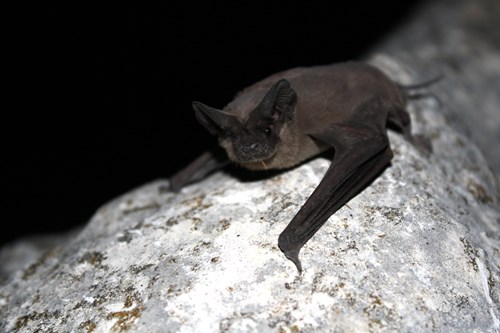
Spookiest behavior: Bats have evolved long fingers with skin between each finger. They use their enlarged hands to fly.
Where can we find them at DMNS? You can find these bats on the second floor in the North American Wildlife Hall. There you’ll find information about the summer roost of 250,000 bats in the San Luis Valley. Don’t forget to look up!
Why is it important to protect them? Bats can eat their bodyweight in insects every night! This makes them an important part of controlling the insect population, including some crop pests and mosquitos. By eating insects, they help keep their ecosystem healthy and balanced.
Credit: Andie Carrillo, manager of the zoology prep lab at the Denver Museum of Nature & Science.
Grand Canyon Black Tarantula
Scientific name: A. behlei has been synonymized and is now A. marxi.
Diet: Small invertebrates, especially insects and other arachnids
Sleeping pattern: These tarantulas are active in the evening and at night and rest in burrows during the day; no one really knows if they “sleep”.
Normal behavior: Ground hunting for prey when hungry (both sexes); males will wander looking for females during the mating season (most die soon after mating). This species lives in various habitats of higher elevation around the Four Corners region, including Colorado, southeastern Utah, and throughout Arizona and New Mexico.
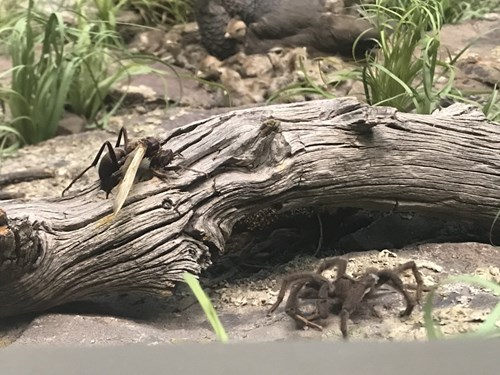
Spookiest behavior: Everybody thinks all spiders are spooky, just because they’re spiders— walking differently, making webs, (of course, tarantulas don’t make webs), but really, are they only just “spooky” in our minds?
Spookier and scarier by far is the Tarantula Hawk Wasp that may sting the tarantula, not killing but only paralyzing it, to drag it back to its excavated hole and lay an egg on the spider’s body. When the larva hatches, it starts eating the tarantula while the spider is still alive! This wasp is a parasitoid, one of the truly spookiest things in nature.
Where can we find them at DMNS? On Level 3, in Explore Colorado Hall (Meade Hall), in the Piñon-Juniper Woodland diorama. In this diorama, it is listed by the outdated name Rechostica (Aphonopelma) behlei
Why is it important to protect them? All spiders, including tarantulas, eat harmful insects and help control their numbers; in turn, spiders are often eaten by other animals in nature’s food web. If we lose spiders, we lose both of these beneficial aspects.
Credit: Jeff Stephenson, science liaison at the Denver Museum of Nature & Science.
Grey Wolf
Scientific name: Canis lupus
Diet: Carnivores (mostly eat meat)
Sleeping pattern: Wolves use a lot of energy while hunting, so they also spend a lot of time sleeping and resting after a meal.
Normal behavior: They typically live together in packs since they are social animals, and they commonly travel 30 miles a day.

Spookiest behavior: They howl which can sound very haunting and can be heard over long distances. This is how they communicate with other wolves. (See example)
Where can we find them at DMNS? The museum has wolves displayed in two dioramas. Both dioramas are on the 2nd floor of the North American Wildlife Hall and depict Alaska grey wolves and Arctic white wolves. The museum also has a display on the 1st floor (near the down escalator) that talks about wolves in Colorado.
Why is it important to protect them? Wolves were almost eradicated from the lower 48 states about 80-100 years ago. Because of conservation efforts, wolves have made a comeback in many states, and Colorado is planning to reintroduce them in the next few years. Wolves were once part of the Colorado wilderness and can play an important role in regulating populations of elk and other ungulates.
Credit: John Demboski, curator of mammals at the Denver Museum of Nature & Science.
Great Horned Owl
Scientific name: Bubo virginianus
Diet: Their primary prey is small mammals like mice, voles, rats and chipmunks. However, they can also take down mammals and birds larger than themselves and will even eat scorpions and snakes.
Sleeping pattern: Great Horned Owls are generally nocturnal, but they will sometimes be active in the early morning or late afternoon especially when food is in short supply.
Normal behavior: They strike their prey from above using an aerial dive and have special feather structure that allows them to fly silently surprising their unsuspecting prey.
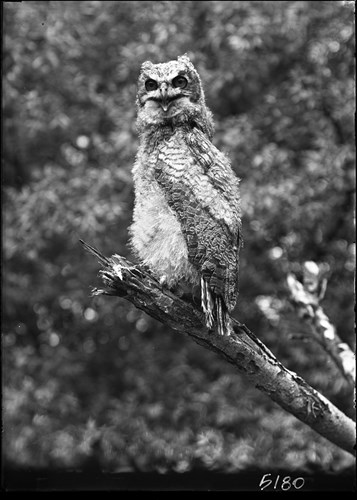
Spookiest behavior: Great Horned Owls have large bones in their eyes (called sclerotic rings). Therefore, they can't move their eyes to scan for prey. Instead, they must turn their entire head, and can turn their head nearly 360-degrees! Their razor sharp talons require over 28 pounds of force to unclench, and they use these strong, sharp tools to crush the spine of their prey!
Where can we find them at DMNS? You can find a Great Horned Owl in the White-tailed deer diorama in the Edge of the Wild.
Why is it important to protect them? Great Horned Owls are nature’s pest control!
Credit: Garth M. Spellman, curator of ornithology at the Denver Museum of Nature & Science.
Raven
Scientific name: Corvus corvus
Diet: Pretty much whatever they can get their bills on! They are omnivorous and will eat anything from small mammals and birds to eggs and berries. Ravens can often been found scavenging off carcasses or pulling our left-overs from trash bins or the local dump.
Sleeping pattern: Diurnal – active during the day and sleep at night.
Normal behavior: Ravens are some of the smartest birds and are very social. They often hunt in groups. For example, one bird will distract an adult bird while another raven sneaks in to steal that bird’s eggs. They are extremely playful!
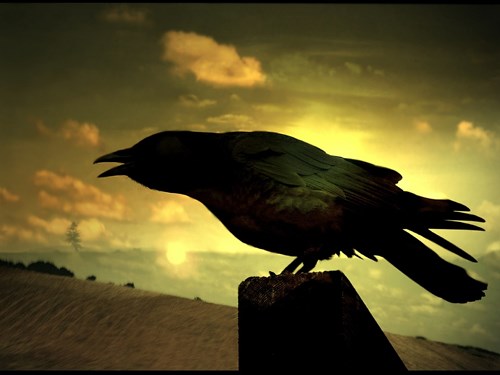
Spookiest behavior: I don’t know about you, but I’d say egg stealing is pretty creepy. Plus a group of Ravens is called a “conspiracy” – they must be up to something!
Where can we find them at DMNS? To see a Raven at the museum, you would need to go into our collections, which would require further requests. However, many of their distant relatives can be found in the dioramas – look for jays, crows and nutcrackers.
Why is it important to protect them? Ravens thrive among humans. A local decline in Ravens is likely a good indication that something in that environment is off or ill and could negatively affect the human environment. So, it is best to keep those Ravens healthy and thriving.
Credit: Garth M. Spellman, curator of ornithology at the Denver Museum of Nature & Science.
Death's Head Hawkmoth
Scientific name: Genus Acherontia (three species in Europe, Asia, and Africa). This is the moth from the Silence of the Lambs movie.
Diet: The caterpillar eat leaves of nightshades (as the leaves are poisonous, the caterpillars become poisonous to their predators), olives and cannabis. Adults eat nectar and honey.
Sleeping pattern: They are active during the evening and night and rest during the day.
Normal behavior: They fly from flower to flower at night to consume nectar.
Related: Miller Moths and Their Annual, Strenuous Migration
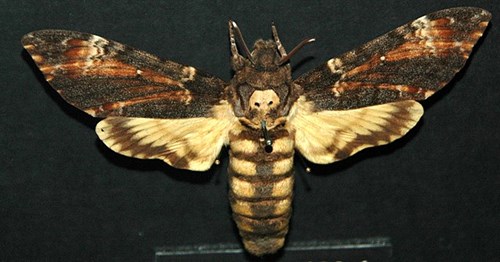
Spookiest behavior: The invade honeybee hives and east honey and nectar. The bees do not recognize them as intruders, since they mimic the small honeybees. When they are disturbed, they can loudly squeak. Their thorax shows a pattern that vaguely resembles a human skull. When resting upside down, this pattern could be part of a deterring shape of the head of a larger animal.
Where can we find them at DMNS? Not in the insect nook! In the insect drawer hanging in the Diversity case on the second floor.
Why is it important to protect them? While beekeepers don’t like these moths, they are pollinators. If we need a reason to protect another species, we share the planet with, then this would be one.
Credit: Frank Krell, curator of entomology at the Denver Museum of Nature & Science.
Scarier than a black cat? A black Leopard!
Scientific name: Panthera pardus
Diet: Carnivore – small (birds or hares) to medium sized animals (duiker or impala)
Sleeping pattern: Commonly nocturnal (sleep in the day), but diurnal/crepuscular in certain parts of their range based on habitat and habits of dominant prey species (Range includes most of sub-Saharan Africa and much of southern Asia.)
Normal behavior: Leopards are primarily solitary, and somewhat nomadic individuals; except for mothers living with recent offspring. Often seen resting in trees when not prowling for prey.
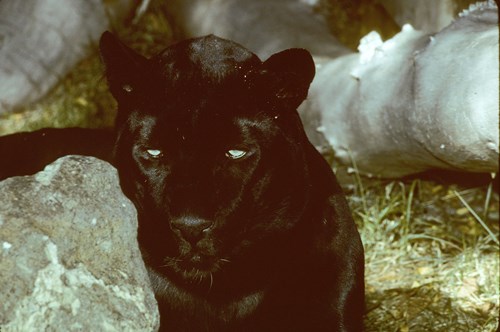
Spookiest behavior: Leopards like to consume their prey high in tree branches to stay out-of-reach from competitors like lions and hyenas. Cached carcasses can be quite a startling sight for an unsuspecting birdwatcher! Although they are a distant relative, at 4 to 5 times the size of our beloved house cats, Leopards are dangerous predators and are not meant for cuddling. Just as our cats come in different colors, some leopards are melanistic, meaning their fur is very dark or even black (often called the black panther). Bad luck or not, you probably don’t want this cat crossing your path!
Where can we find them at DMNS?: 3rd floor – Botswana Hall – Night on the Kalahari
Why is it important to protect them? Leopards play an important role as predators in ecosystems. They keep prey populations healthy by removing sick and injured individuals. Leopards help maintain healthy plant communities by regulating herbivore populations and influencing their behaviors (keeping them on the move). Habitat destruction and fragmentation represent the most significant threat to their survival, but leopards are also threatened by human-wildlife conflicts (e.g., livestock interactions) and poaching.
Credit: Andrew Doll, Zoology Assistant Collections Manager, Learn more about his research here.


